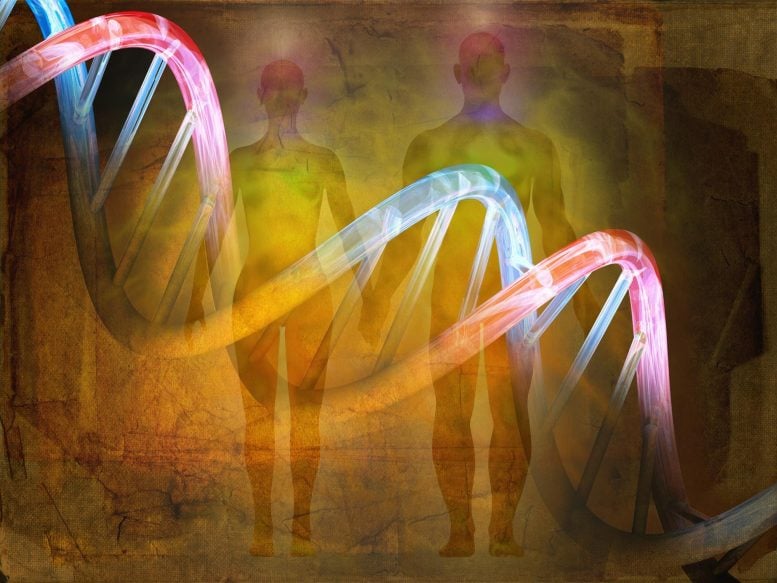"Unraveling Ancestral Triumphs: The Survival of Modern Humans in Frozen Climates"

Research on the FTO gene variant rs1421085 T>C suggests it evolved to aid human survival in cold climates by boosting fat thermogenesis, possibly explaining its high prevalence in populations that migrated from Africa to colder regions. This finding links genetic traits associated with modern obesity to historical adaptations, underscoring the complex interplay between genetics and evolution.
Recent research supports the “Out-of-Africa” theory, showing how the FTO gene variant rs1421085 T>C has helped humans adapt to colder climates by enhancing thermogenesis in brown adipose tissue (BAT), providing a survival advantage. This variant’s prevalence in colder regions indicates positive selection, although anomalies in the Indian subcontinent suggest historical migrations have also impacted gene frequencies. This study underscores the complex interplay between evolution, history, and genetics, necessitating further exploration into human adaptation.
“Who are we, and where do we come from?” This fundamental question has fascinated humanity for millennia. The widely accepted “Out-of-Africa (OOA) theory” posits that modern humans, Homo sapiens, originated in Africa. Evidence suggests that a small group of modern humans migrated out of Africa around 70,000 years ago, and nearly all humans outside of Africa today are believed to be descendants of these early pioneers.
Serving as a shelter, Africa protected modern humans from extreme cold conditions during repeated ice ages. Early humans adapted to the heat dissipation requirements of running on the East African grasslands by losing their thick body hair. However, when the ancestors of modern humans left Africa, they encountered the survival challenges as previous pioneers did: how to keep their bodies warm in extremely cold climates. Are there remnants in the human genome that reflect the evolutionary adaptations of our ancestors who endured extreme environments?
Genome-wide association studies (GWAS) have significantly advanced disease genetics and provided invaluable tools for exploring human evolutionary events. In 2007, a cluster of single nucleotide polymorphisms (SNPs) within intron 1 of the FTO (fat mass and obesity-associated) gene was identified as being most strongly associated with obesity risk. However, it remained unclear whether these SNPs directly contribute to the development of obesity. The turning point came in 2015 when Claussnitzer et al. published a milestone article in the New England Journal of Medicine.
The study pinpointed the rs1421085 T>C variant within the FTO SNP cluster for the first time, showing that this variant inhibited the expression of UCP1 (uncoupling protein 1), a core gene of thermogenesis, and reduced thermogenic capacity of differentiated human beige fat cells. While this study appears to elucidate the molecular mechanism of FTO variants in obesity, it is noted that there is a lack of direct in vivo evidence to support these findings.
In 2023, a research group published a paper in Nature Metabolism that challenged the above conclusions. The findings revealed that mice carrying the homozygous CC-alleles exhibit enhanced brown adipose tissue (BAT) thermogenesis and resistance to high-fat diet-induced obesity. Notably, mice harboring the CC-alleles showed ~6 °C higher than those with TT-alleles when exposed to a cold room (4 °C). These results led us to speculate that the rs1421085 T>C variant might be related to mammals’ adaptation to cold environments.
To further investigate whether the rs1421085 T>C variant affects thermogenesis in humans, we recently conducted a study using human fetal BAT obtained from aborted samples due to developmental defects. The results demonstrated that TC-allele carriers owed higher expression of UCP1 in BAT than TT-allele carriers, aligning with the team’s previous observations in mice. This discovery prompted us to reassess the connection among the rs1421085 T>C variant, obesity, and human evolutionary processes. Could the expansion of this variant be attributed to positive selection for human adaptation to cold environments?
Over the last 100,000 years, modern humans have migrated from low latitudes to high latitudes, transitioning from tropical and temperate zones to colder regions, and shifting from hunter-gatherer societies to agricultural and pastoral lifestyles. These environmental changes have imposed evolutionary pressures that have played a pivotal role in shaping phenotypic diversity across diverse populations. For instance, the Inuit population residing in the frigid Arctic region heavily relies on marine fish abundant in omega-3 polyunsaturated fatty acids (PUFAs) for their diet. The most prominent signal of positive selection is observed within the fatty acid desaturase (FADS) gene. Notably, these genetic variants were initially associated with height traits in general populations. Could a comparable mechanism of positive selection elucidate the narrative behind the rs1421085 T>C variant?
Thus, using a systematic analysis of the rs1421085 C-allele frequency among diverse ancestral groups, we observed a remarked inverse correlation between the C-allele frequency and mean earth skin temperatures in January. This observed pattern indicates that “the colder the location, the higher the frequency of this variant”. In contrast, no correlation was found between the frequency and longitudes or altitudes among populations. Interestingly, the step-by-step shift of the C-allele frequency tracked the “modern human migration route map” documented previously. Building on these human and mouse results, encompassing both in vitro and in vivo experiments, and considering the genetic distribution patterns of Eurasian and African populations, we proposed a hypothesis that the substantial variance in the C-allele frequency across populations from Africa to Eurasia might be driven by positive selection mechanisms linked to varying levels of cold stress.




